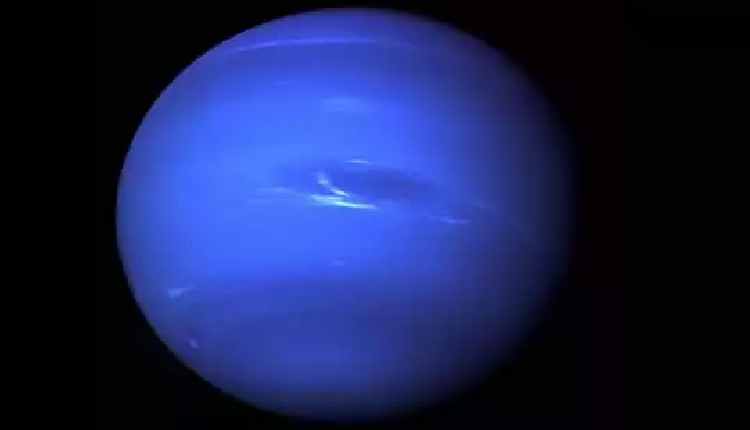Washington: Astronomers have uncovered a link between Neptune’s disappearing clouds and the increasing activity of the Sun as it approaches its solar cycle, expected to occur in 2025.
The Sun is currently in an active phase of its 11-year solar weather cycle, known as Solar Cycle 25. The solar cycle is the period when the Sun’s magnetic field flips every 11 years as it becomes more tangled like a ball of yarn. This is evident in the increasing number of sunspots and increasing solar flare activity.
As the cycle progresses, the Sun’s tempestuous behaviour builds to a maximum, until the magnetic field breaks down and reverses polarity. Then the Sun settles back down to a minimum, only to start another cycle.
The link between Neptune and solar activity is surprising to planetary scientists because Neptune is the farthest major planet in the solar system. It receives sunlight with about 0.1 per cent of the intensity Earth receives.
Yet Neptune’s global cloudy weather seems to be driven by solar activity, and not the planet’s four seasons, which each last approximately 40 years.
The team led by University of California (UC) Berkeley discovered the connection between the solar cycle and Neptune’s cloudy weather pattern by looking at 2.5 cycles of cloud activity recorded over the 29-year span of Neptunian observations.
During this time, the planet’s reflectivity increased in 2002 then dimmed in 2007. Neptune became bright again in 2015, then darkened in 2020 to the lowest level ever observed, which is when most of the clouds went away.
At present, the cloud coverage seen on Neptune is extremely low, with the exception of some clouds hovering over the giant planet’s south pole, the team wrote in the paper published in the journal Icarus.
“I was surprised by how quickly clouds disappeared on Neptune,” said Imke de Pater, professor of astronomy at UC Berkeley.
“We essentially saw cloud activity drop within a few months,” she said.
“Even now, four years later, the most recent images we took this past June still show the clouds haven’t returned to their former levels,” said Erandi Chavez, a graduate student at the Center for Astrophysics | Harvard-Smithsonian (CfA) in Cambridge, Massachusetts, who led the study when she was an undergraduate astronomy student at UC Berkeley.
“This is extremely exciting and unexpected, especially since Neptune’s previous period of low cloud activity was not nearly as dramatic and prolonged.”
To monitor the evolution of Neptune’s appearance, Chavez and her team analysed Keck Observatory images taken from 2002 to 2022, the Hubble Space Telescope archival observations beginning in 1994, and data from the Lick Observatory in California from 2018 to 2019.
The images reveal an intriguing pattern between seasonal changes in Neptune’s cloud cover and the solar cycle.
When it’s stormy weather on the Sun, more intense ultraviolet (UV) radiation floods the solar system. The team found that two years after the solar cycle’s peak, an increasing number of clouds appear on Neptune. The team further found a positive correlation between the number of clouds and the ice giant’s brightness from the sunlight reflecting off it.
“These remarkable data give us the strongest evidence yet that Neptune’s cloud cover correlates with the Sun’s cycle,” said de Pater. “Our findings support the theory that the Sun’s UV rays, when strong enough, may be triggering a photochemical reaction that produces Neptune’s clouds.”
(IANS)















